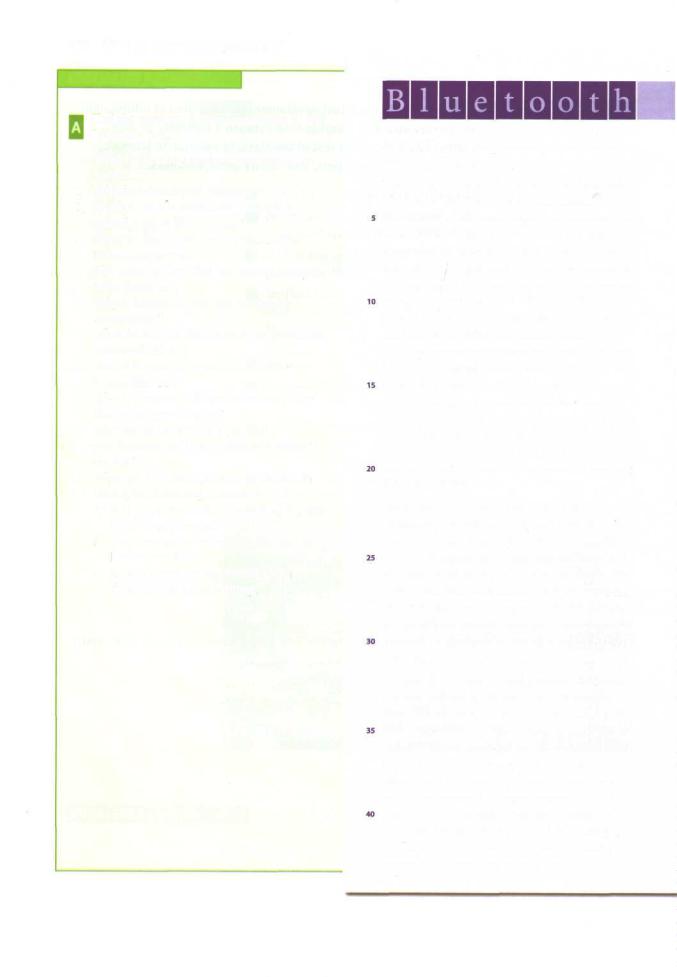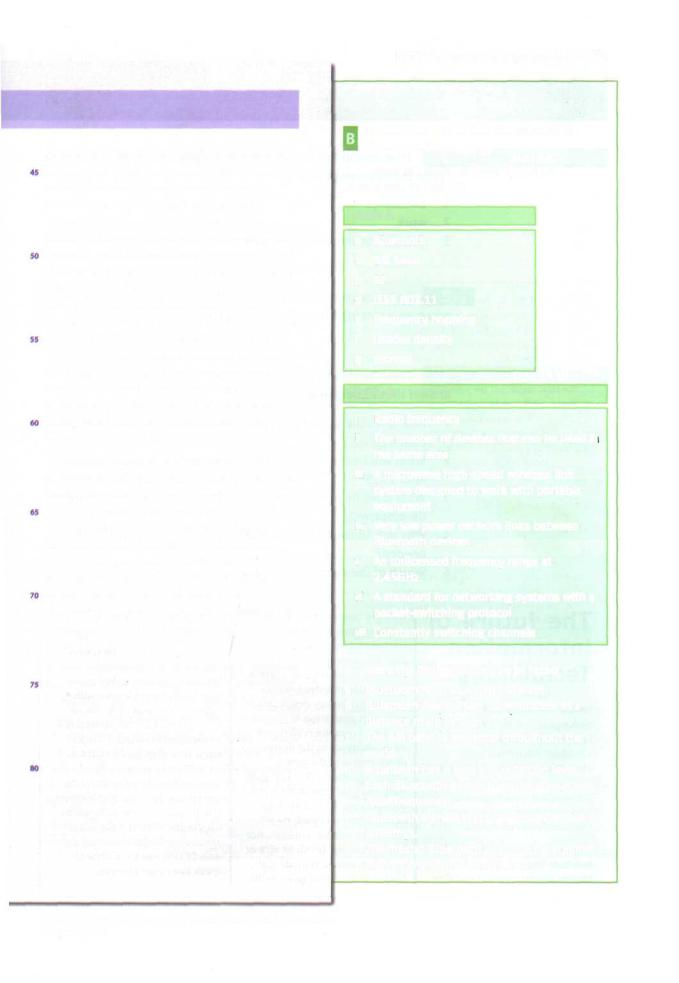
Oxford English for Information Technology / unit23
.pdf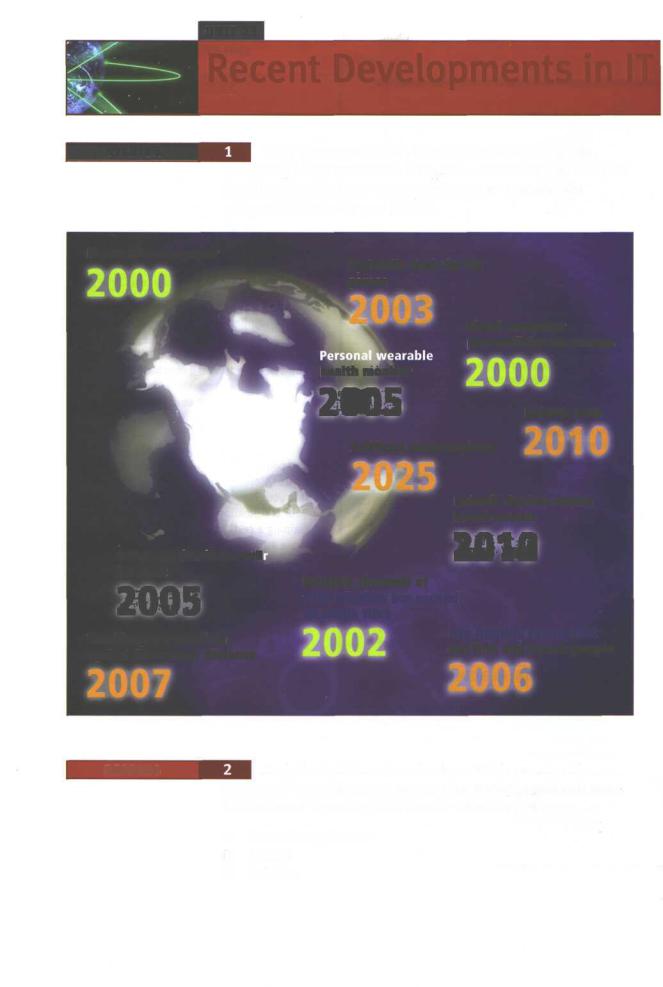
UNIT 23
Recent Developments in IT
STARTER |
Study these predictions of developments in Information |
|
Technology from 1997. Which, if any, have come true? How likely are |
|
the others to come true? Give reasons for your decisions and |
|
compare answers with your partner. |
Electronic newspaper
Hydraulic chair for VR games
|
Visual computer |
|
personalities on screens |
health monitor |
|
2005 |
Robotic pets |
Artificial brain implants
Intranets dominate ove Internet
2005
Terabits per second on optical fibres over distance
Robotic devices within blood vessels
2010
Multiple channels of >100 Gigabits per second on single fibre
Fire fighting robots that can find and rescue people
READING |
Study the texts on recent developments in one area of |
|
Information Technology, A, B or C, as your teacher directs and make |
|
brief notes on the main points in each of the two texts. |
A Domestic appliances
BAvatars
CRobotics
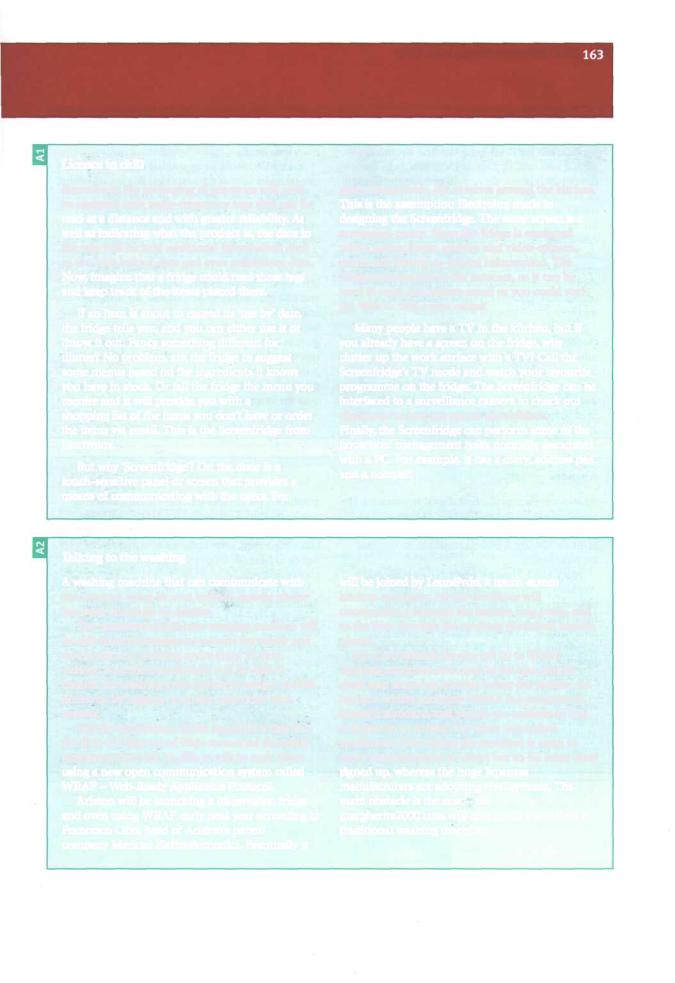
Licence to chill
Barcodes in the packaging of groceries will soon be replaced with radio-frequency tags that can be read at a distance and with greater reliability. As well as indicating what the product is, the data in the tags will include additional information such as the 'best before' date and even nutritional data. Now, imagine that a fridge could read these tags and keep track of the items placed there.
If an item is about to exceed its 'use by' date, the fridge tells you, and you can either use it or throw it out. Fancy something different for dinner? No problem, ask the fridge to suggest some menus based on the ingredients it knows you have in stock. Or tell the fridge the menu you require and it will provide you with a
shopping list of the items you don't have or order the items via email. This is the Screenfridge from Electrolux.
But why 'Screenfridge'? On the door is a touch-sensitive panel or screen that provides a means of communicating with the users. For
many households, life revolves around the kitchen. This is the assumption Electrolux made in designing the Screenfridge. The same screen is a messaging centre. Since the fridge is equipped with a microphone, speaker and video-camera, you're not limited to textual information. The fridge is connected to the Internet, so it can be used to send and receive email or you could surf the Web to find a new recipe.
Many people have a TV in the kitchen, but if you already have a screen on the fridge, why clutter up the work surface with a TV? Call the Screenfridge's TV mode and watch your favourite programme on the fridge. The Screenfridge can be interfaced to a surveillance camera to check out visitors or to keep an eye on the children.
Finally, the Screenfridge can perform some of the household management tasks normally associated with a PC. For example, it has a diary, address pad and a notepad.
Talking to the washing
A washing machine that can communicate with the Internet using its own built-in mobile phone has been launched by Ariston.
The margherita2000.com washing machine will be able to send breakdown reports for repair and download new washing cycles from its own website. And the householder will be able to control the washing cycle remotely using a mobile phone or by logging on to the machine's own website.
But the importance of the machine is that it is the first of a line-up of Web-connected domestic appliances that will be able to talk to each other using a new open communication system called WRAP - Web-Ready Appliances Protocol.
Ariston will be launching a dishwasher, fridge and oven using WRAP early next year according to Francesco Caio, head of Ariston's parent
company Merloni Elettrodomestici. Eventually it
will be joined by Leon@rdo, a touch-screen kitchen computer. All the machines will communicate through the house's ring main, and to the Web through the washing machine's mobile phone.
Mr Caio believes he can sell 30 to 50,000 washing machines each year in Europe. But he must leap some big hurdles before the system can become widely accepted. WRAP is a proprietary Merloni standard, and people are unlikely to buy if locked in to Ariston for other networked appliances. Caio claims the standard is open to other manufacturers to adopt but so far none have signed up, whereas the huge Japanese manufacturers are adopting rival systems. The main obstacle is the cost - the margherita2000.com will .cost much more than a traditional washing machine.
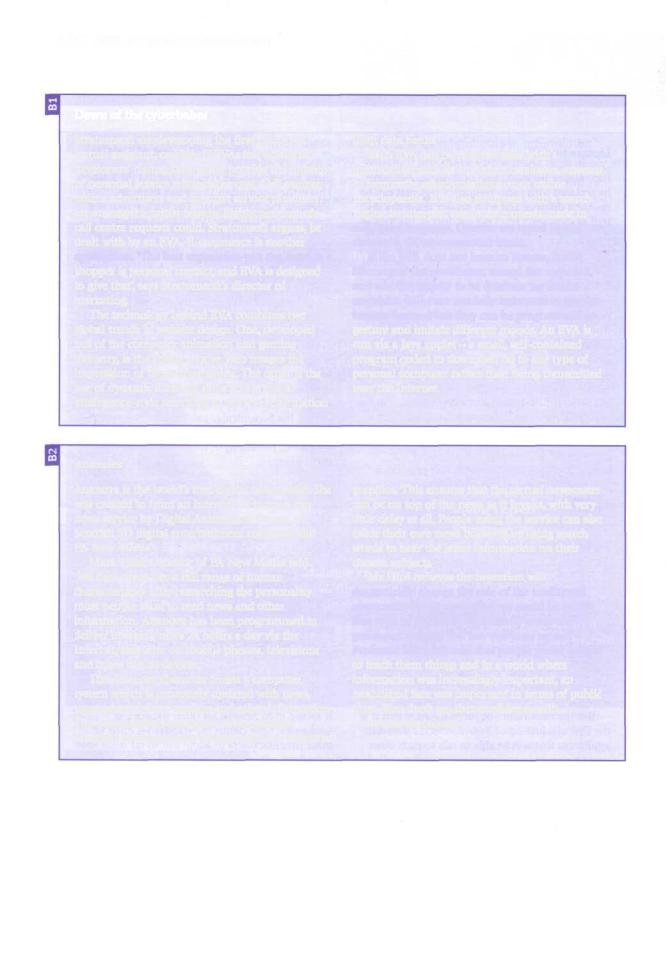
164 UNIT 23 Recent Developments in IT
Dawn of the cyberbabes
Stratumsoft are developing the first electronic virtual assistant, or EVA. If EVAs live up to the developers' claims, they could provide the illusion of personal service without the cost. Call centres, online advertisers and Internet service providers are among the initial targets. Eighty per cent of call centre requests could, Stratumsoft argues, be dealt with by an EVA. E-commerce is another application. 'The best experience you can have as a shopper is personal contact, and EVA is designed to give that', says Stratumsoft's director of marketing.
The technology behind EVA combines two global trends in website design. One, developed out of the computer animation and gaming industry, is the ability to give Web images the impression of three dimensions. The other is the use of dynamic database skills and artificial intelligence-style searching to retrieve information
from data banks.
Each EVA can be programmed with information such as a product catalogue, answers to frequently asked questions or an online encyclopaedia. It is also equipped with a search engine to interpret customer requests made in colloquial language. Queries are typed in and answered via on-screen text boxes.
If the EVA does not have an answer, it will interrogate the questioner, record the response, and add the answer to its database for future enquiries. EVAs are not fully animated to imitate human features but they can be programmed to gesture and imitate different moods. An EVA is run via a Java applet - a small, self-contained program coded to download on to any type of personal computer rather than being transmitted over the Internet.
Ananova
Ananova is the world's first digital newsreader. She was created to front an Internet 24 hours a day news service by Digital Animations Group, a Scottish 3D digital entertainment company and PA New Media.
Mark Hird, Director of PA New Media said, 'We have given her a full range of human characteristics after researching the personality most people want to read news and other information. Ananova has been programmed to deliver breaking news 24 hours a day via the Internet, and later on mobile phones, televisions and other digital devices.'
The Ananova character fronts a computer system which is constantly updated with news, sport, share prices, weather and other information. This is converted into speech while another program simultaneously creates real-time animated
graphics. This ensures that the virtual newscaster can be on top of the news as it breaks, with very little delay at all. People using the service can also tailor their own news bulletins by using search words to hear the latest information on their chosen subjects.
Mr Hird believes the invention will dramatically change the role of the traditional newscaster, 'In 20 years time we could be seeing that type of job being replaced by computergenerated images.' But not everyone agrees. Professor Bill Scott said that people prefer people to teach them things and in a world where information was increasingly important, an established face was important in terms of public trust. 'You don't get that confidence with computer characters.'
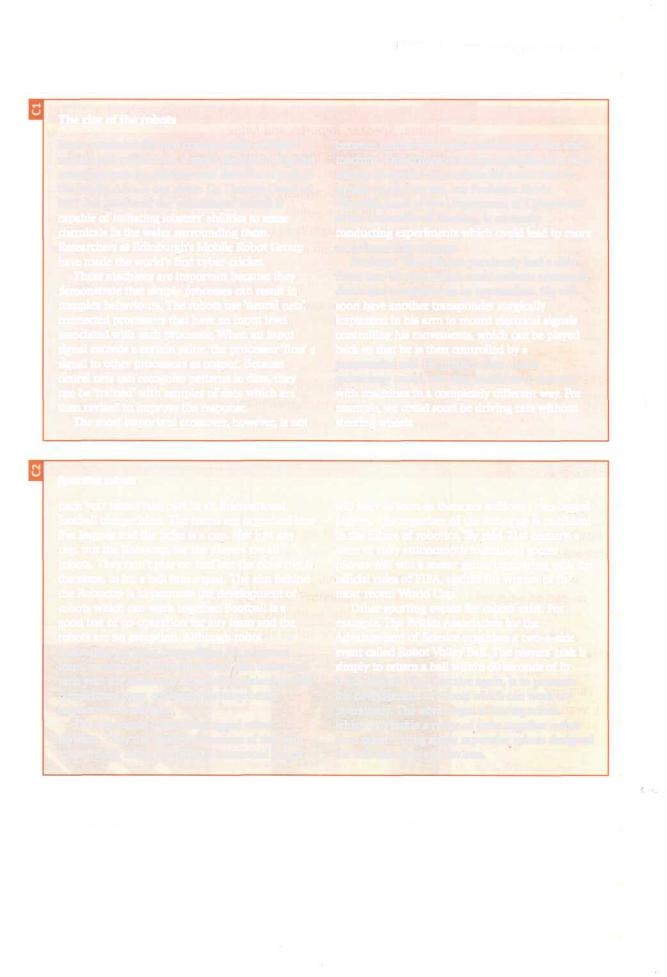
The rise of the robots
Japan produced the first commercially available robotic pet, called Aibo, a small electronic dog that several owners on Aibonet.com describe as part of the family. Aibo is not alone. Dr Thomas Consi of MIT has produced the 'robolobster' which is capable of imitating lobsters' abilities to sense chemicals in the water surrounding them. Researchers at Edinburgh's Mobile Robot Group have made the world's first cyber-cricket.
These machines are important because they demonstrate that simple processes can result in complex behaviours. The robots use 'neural nets', connected processors that have an input level associated with each processor. When an input signal exceeds a certain value, the processor 'fires' a signal to other processors as output. Because neural nets can recognise patterns in data, they can be 'trained' with samples of data which are then revised to improve the response.
The most important crossover, however, is not
Sportingrobots
Each year teams take part in an international football competition. The teams are organised into five leagues and the prize is a cup. Not just any cup, but the Robocup, for the players are all robots. They don't play on turf but the objective is the same, to hit a ball into a goal. The aim behind the Robocup is to promote the development of robots which can work together. Football is a good test of co-operation for any team and the robots are no exception. Although robot footballers are poor competition for a human team, each year their performance gets better and each year the standards expected are raised so that competitors must constantly develop better hardware and software.
The top league is the Sony legged robot division. They use modified versions of the wellknown Sony robodog AIBO. A humanoid league
UNIT 23 Recent Developments in IT 165
between animal and robot but between man and machine. Quadriplegics and paraplegics have been testing computer connections for some time to bypass injured nerves, but Professor Kevin Warwick, head of the Department of Cybernetics at the University of Reading, is currently conducting experiments which could lead to more of us becoming cyborgs.
Professor Warwick has previously had a chip fitted into his arm which could activate sensors in doors and computers as he approached. He will soon have another transponder surgically implanted in his arm to record electrical signals controlling his movements, which can be played back so that he is then controlled by a prerecorded self. He predicts that such a technology could, one day, enable us to interact with machines in a completely different way. For example, we could soon be driving cars without steering wheels.
will start as soon as there are sufficient two-legged players. The organiser of the Robocup is confident in the future of robotics, 'By mid-21st century, a team of fully autonomous humanoid soccer players will win a soccer game, complying with the official rules of FIFA, against the winner of the most recent World Cup.'
Other sporting events for robots exist. For example, The British Association for the Advancement of Science organises a two-a-side event called Robot Volley Ball. The players' task is simply to return a ball within 60 seconds of its being served. The objective again, is to promote the development of robots which can work cooperatively. The advantages of having robots which can tackle a range of tasks together rather than constructing single expensive robots designed for one task only are obvious.
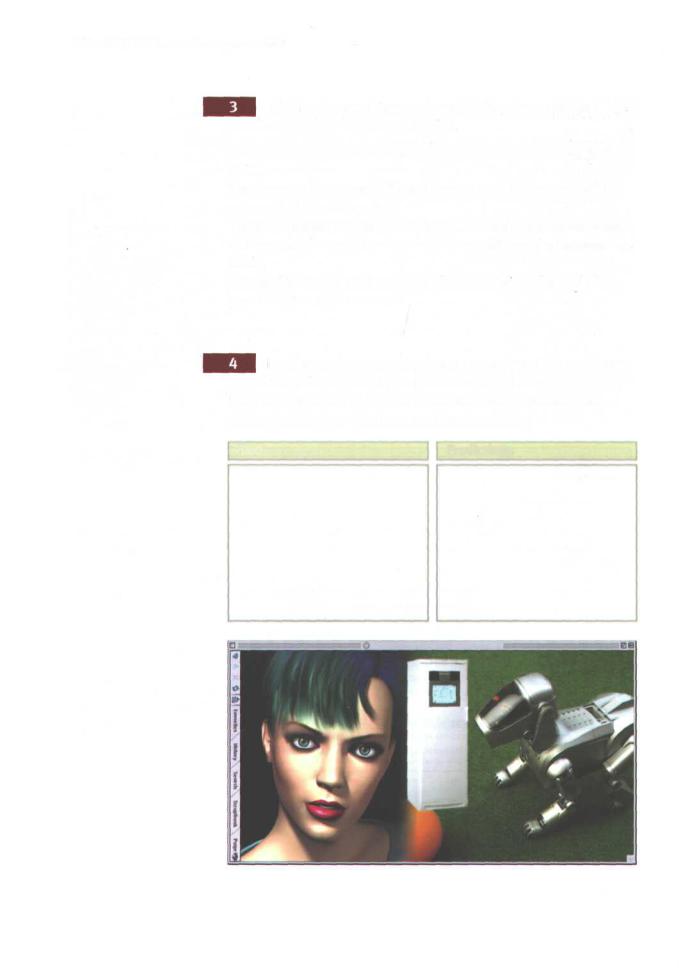
166 UNIT 23 Recent Developments in IT
Work in groups of three, A, B and C. Play these roles in rotation: Speaker, Reporter and Judge.
The Speaker explains the main points of one text using only their notes.
The Reporter listens carefully and reports back to the Speaker a summary of the main points.
The Judge listens carefully to both Speaker and Reporter and points out any mistakes, main points omitted or additions the Reporter has made.
Repeat this activity until you have played all three roles and all of your texts have been covered.
List the predictions, if any, in the articles you have read. Have any of them already taken place since the article was written? How likely are the others to happen in the near future? Discuss your answers with others who have read the same texts.
Text |
Predictions |
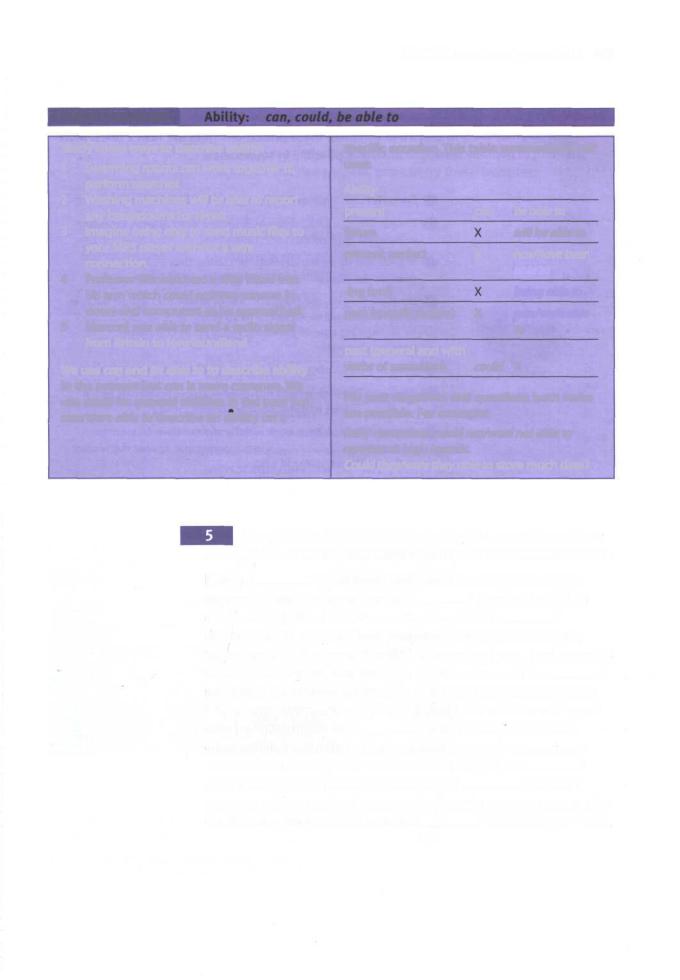
LANGUAGE WORK
Study these ways to describe ability:
1Swarming robots can work together to perform searches.
2Washing machines will be able to report any breakdowns for repair.
3Imagine being able to send music files to your MP3 player without a wire
connection.
4Professor Warwick had a chip fitted into his arm which could activate sensors in doors and computers as he approached.
5Marconi was able to send a radio signal from Britain to Newfoundland.
We use can and be able to to describe ability in the present but can is more common. We use could for general abilities in the past but was/were able to describe an ability on a
UNIT 23 Recent Developments in IT 167
specific occasion.This table summarises their uses:
Ability |
|
|
present |
can |
be able to |
future |
|
will be able to |
present perfect |
X |
has/have been |
|
|
able to |
-ingform |
|
being able to |
past (specific action) |
X |
was/were able |
|
|
to |
past (general and with |
|
|
verbs of sensation) |
could |
X |
For past negatives and questions both verbs are possible. For example:
Early computers could not/were not able to operate at high speeds.
Could they/were they able to store much data?
Complete the blanks in this text using the correct form of can or be able to. In some cases there is more than one possible answer.
Imagine  open doors and switch on computers as you approach them. ProfessorWarwick
open doors and switch on computers as you approach them. ProfessorWarwick  because he had an electronic chip fitted into his arm for a month. He
because he had an electronic chip fitted into his arm for a month. He  demonstrate to the press how computers would greet him with, 'Good morning, Professor Warwick' as he walked past. Next he wants to record the signals from his brain to his arm to see if he
demonstrate to the press how computers would greet him with, 'Good morning, Professor Warwick' as he walked past. Next he wants to record the signals from his brain to his arm to see if he  program a computer to operate his arm. In the long term, this may help people who
program a computer to operate his arm. In the long term, this may help people who  use their limbs. His wife too will have a chip implanted. They hope
use their limbs. His wife too will have a chip implanted. They hope  feed messages into each other's brains. According to the Professor, one day we
feed messages into each other's brains. According to the Professor, one day we  communicate directly with machines. If he is right, we
communicate directly with machines. If he is right, we  drive a car from the passenger seat and we
drive a car from the passenger seat and we  operate a computer without using a mouse or keyboard. However, there is also the alarming prospect that someone
operate a computer without using a mouse or keyboard. However, there is also the alarming prospect that someone  hack into your brain.
hack into your brain.
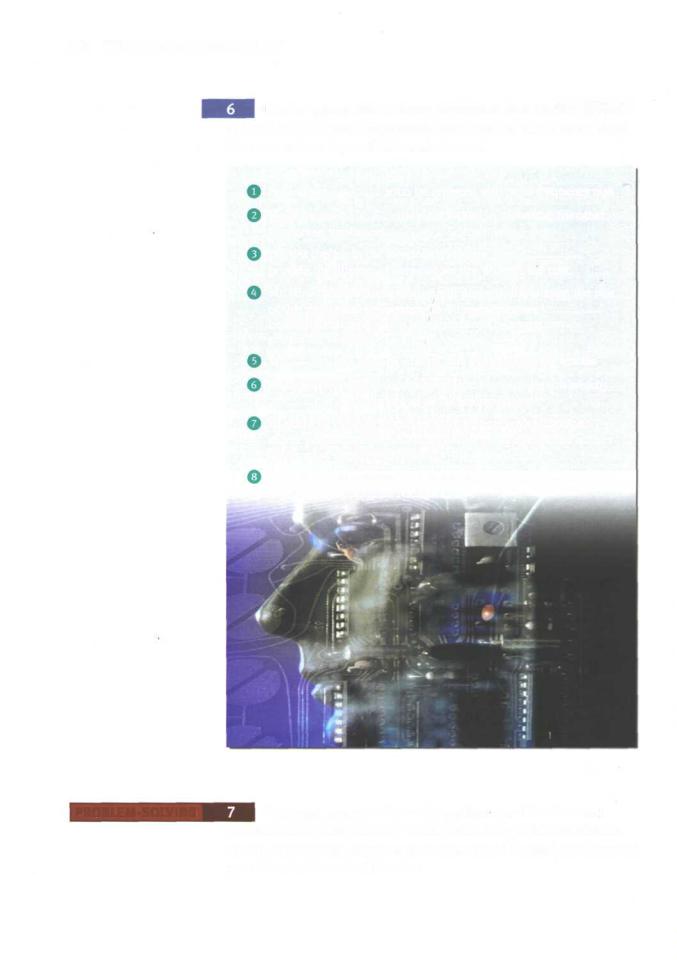
168 UNIT 23 Recent Developments in IT
Use an appropriate certainty expression from the list studied in Unit 16 to complete these predictions from the Task 2 texts. More than one answer is possible in some cases.
Barcodes soon be replaced with radio-frequency tags.
soon be replaced with radio-frequency tags.
People are  to buy if locked in to Ariston for other networked appliances.
to buy if locked in to Ariston for other networked appliances.
If EVAs live up to the developers' claims, they provide the illusion of personal service without die cost.
provide the illusion of personal service without die cost.
Mr Hird believes the invention will dramatically change the role of the traditional newscaster, 'In 20 years' time we be seeing that type ofjob being replaced by computergenerated images.'
be seeing that type ofjob being replaced by computergenerated images.'
We  soon be driving cars without steering wheels.
soon be driving cars without steering wheels.
Professor Warwick is currently conducting experiments which  lead to more of us becoming cyborgs.
lead to more of us becoming cyborgs.
By mid-21st century, a team of fully autonomous humanoid soccer players win a soccer game against the winner of the most recent World Cup.
win a soccer game against the winner of the most recent World Cup.
A virtual world populated by virtual humans  become a very tangible reality.
become a very tangible reality.
PROBLEM-SOLVING |
In groups, choose a domestic appliance and decide what |
|
functions an in-built computer would allow it to perform in addition |
|
to its basic function. Consider also how it could be marketed. Present |
|
your ideas to the rest of the class. |

|
UNIT 23 Recent Developments in IT 169 |
SPEAKING |
Search for the latest developments in the area of Information |
Technology you read about in Task 2. Make a summary of your findings to report to the rest of the class. In addition to journals, magazines and newspapers, you can try these websites:
Domestic appliances
www.electrolux.co.uk
www.merloni.com
www.margherita.com
www.aristonchannel.com
www.zanussi.co.uk
www.sony.co.uk
Avatars
www.pulse3d.com
www.kiwilogic.com
www.softimage.com
www.ananova.com
www.biovirtual.com
www.i-dtv.com
www.bt.com/talkzone
www.digimask.com
www.channel5.co.uk
Robotics
www.aibo-europe.com
www.honda.co.jp/english/technology/robot
www.robotbooks.com/Mitsubishi-robots.htm
WRITING |
Convert your notes for Task 8 into a written report. Your report |
should have these sections: |
|
1 |
Area of IT-definition |
2 |
Technology involved - hardware and software |
3 |
Applications |
4 |
Possible future developments |
